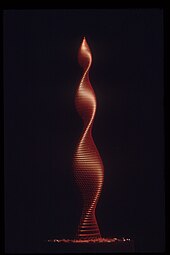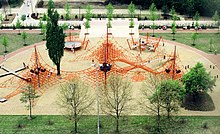Conrad Roland
Conrad Roland (* 1934 in Munich as Konrad Otto Roland Lehmann ; † September 25, 2020 in Holualoa , Hawaii , USA ) was a German architect and pioneer in the construction of space nets, which up to now have mainly been used as rope climbing devices in playgrounds . For the 1987 Federal Garden Show in Düsseldorf , he constructed what is still the largest spatial network in the world, the super four-mast cable circus.
Live and act
Conrad Roland completed an apprenticeship as a carpenter after graduating from high school . From 1954 to 1963 he studied architecture at the TH Munich and at the Illinois Institute of Technology in Chicago in Mies van der Rohe's master class . From 1959 to 1961 he worked in Mies van der Rohe's Chicago office. In 1962/63 he completed additional studies at the TU Berlin , a. a. in a seminar by Frei Otto .
From 1963 Conrad Roland worked independently in Berlin; He mainly dealt with studies, projects and documentation on hanging houses and space nets. A scholarship from Phyllis Lambert , Montreal, made this possible. In 1964 the project of a 120-storey high-rise building in spiral form, height 440 m, was created as an ideal alternative to the World Trade Center in New York City . In terms of architectural history, it was the first draft of a spiral high-rise. Since the floors are suspended on external ropes (in groups of 12 floors each), they do not have to be stacked vertically on top of each other, as in a conventional high-rise. The wind loads are absorbed by the triangulated outer cable network. The model of the spiral high-rise has been in the collection of the German Architecture Museum since 2019 .
Plans for the construction of a sports stadium in Abu Dhabi , which he developed together with the architect Jörn-Peter Schmidt-Thomsen in 1974, and for a house for Rudolf Augstein in Hamburg in 1967 were never realized.
He also dealt with the topic of spatial network architecture in his book publication Frei Otto - Spans (1965). A fellowship from the Graham Foundation for Advanced Studies in the Fine Arts, Chicago, supported work on this first monograph on Frei Otto. In 1967 Roland was visiting professor in Portsmouth, in 1967 and 1969 he gave numerous lectures on "Suspended Buildings and Spacenets" in the USA, Canada and Mexico.
From 1970 on, the architect devoted himself increasingly to the development of play space nets. For the designs and designs on this construction principle, he received several prizes at home and abroad. a. the "Special Prize Federal Prize Good Form 1971". In 1973 he founded the company "Spielbau Conrad Roland" and in 1975 the company "Corocord Spielbau GmbH" in Berlin, which planned and built play space nets from 1973 to 1985. The successor company Corocord Raumnetz GmbH (until 2019, now KOMPAN A / S) and the Corocord trademark also bear the first letters of his name. From 1973 to 2019 Corocord installed over 10,000 play space nets in 58 countries worldwide. In addition to the play space net patents at home and abroad, a patent for the remuneration of wire ropes wrapped in polyester fiber by induction contributed significantly to increasing the service life of these rope play equipment.
The super two-mast rope circus was created for the 1975 Federal Horticultural Show in Mannheim.
In 1978, in the GSW settlement on Obstallee in Berlin, the highest space net was built with the super ball stop net.
For the Federal Garden Show in Düsseldorf in 1987, Roland constructed what is still the largest spatial network in the world, the super four-mast rope circus in the Südpark Düsseldorf , which is still in operation after a renovation in 2007.
The architect mainly developed spatial nets as rope play equipment for the playground area. In his publications and z. B. the US patent "Three-Dimensional Network" from 1974, however, Conrad Roland always made aware of the many possible uses for space networks, for example for multi-storey greenhouses, trellis, summer houses, beach and exhibition pavilions, but above all as multi-storey living space networks, as he had already demonstrated in the model studies from the 1960s.
From 1987 Conrad Roland lived in Kailua-Kona , Hawaii. He died in Hawaii in September 2020 at the age of 86, where he bought a banana and macadamia nut plantation and started a paradise garden project in Holualoa.
Works
- Frei Otto - spans. Ideas and attempts for lightweight construction . A workshop report from Conrad Roland. Ullstein, Berlin, Frankfurt / Main and Vienna 1965.
- Frei Otto: Tension Structures by Conrad Roland, Translated by CV Amerongen, Praeger Publishers, New York Washington 1970
- Frei Otto: Estructuras , Conrad Roland, Gustavo Gili, Barcelona 1973
- Building with space nets 1 . Play space network + play city. Climbing and play equipment made from spatial rope net constructions. From the children's building game in the play space network to the city building game in the living space network, Berlin 1971 [self-published]
Web links
- Literature by and about Conrad Roland in the catalog of the German National Library
- Oliver Elser: Twenty Feet from Mies to Frei. Bad student and Otto disciple Conrad Roland. In: uncube magazine no.33.
- Space nets. Kompan GmbH
Individual evidence
-
↑ Oliver Elser, Peter Cachola Schmal (ed.): The architecture model. Tool, fetish, little utopia. Catalog German Architecture Museum, Zurich (Scheidegger & Spiess) 2012, pp. 170–175.
New See-Through 'Spacenets' May Rival Skyscapers. In: Courier-Journal & Times. Louisville, Kentucky, USA, November 16, 1969. - ↑ Rope circus ball stop net. In: Deutsche Bauzeitung db issue 8 / 1979.-
- ↑ United States Patent No. 3,970,301 "Three-Dimensional Network", filed August 15, 1974, published July 20, 1976, applicant and inventor: Conrad Roland Lehmann.
- ^ City in the rope network (project). In: Deutsche Bauzeitung db issue 10/1971, p. 1115.
- ↑ Father of the space nets: On the death of Conrad Roland. In: BauNetz . September 28, 2020, accessed September 29, 2020 .
| personal data | |
|---|---|
| SURNAME | Roland, Conrad |
| ALTERNATIVE NAMES | Lehmann, Konrad Otto Roland |
| BRIEF DESCRIPTION | German architect |
| DATE OF BIRTH | 1934 |
| PLACE OF BIRTH | Munich |
| DATE OF DEATH | September 25, 2020 |
| Place of death | Holualoa in Hawaii , United States |




